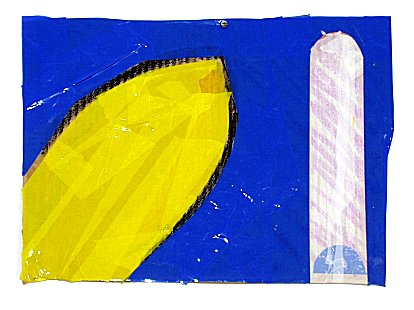|
.jpg)
The
Quay
Acrylic and oil paint on canvas. Painted September 2002
I made these
sketches to explore organic shapes and colours. I also wanted to see
if I could explode/echo/repeat motifs across several paintings, to create
a logical transition with a suggestion of language and rhythm.
MA Proposal Draft One by P. Bright
Organic
& Synthetic
October 2002
Recently I have been creating images with PVC packaging tape. There
are several colours of tape available, ranging from common brown to
vivid reds and blues. These tapes are transparent and can be used in
layers like watercolour paint or lithographic printing. Using tape is
a very quick and physical way to create images. The “plasticness” of
the material has a unique quality and is ideal for creating images that
are bold, strong, colourful and contemporary. Each layer adds depth
and intensity to the colour underneath and like lithography new colours
are created as each transparent layer is added.
|

|
The “plasticness”
of commercial vinyl tapes, their tactile and glossy qualities
make them vibrant and alive; when juxtaposed against natural materials
or organic colours they become a contradiction, a complement,
more intense and more synthetic.
I would
like to continue to explore this medium, to exploit its inherent
qualities and experiment further with the organic and synthetic idea.
|
|
There are
other ways vinyl tape can be used. In a commercial context, the
majority of today's signage and graphic displays are created using
a colour fast, high adhesive vinyl tape. There are thousands of
different colours, tones, densities and thicknesses. There are
hundreds of specialised tapes: pearlescent, opaque, iridescent
etc. It is possible to use a computer to cut sheets of vinyl into
shapes and symbols; using this process gives me the opportunity
to use a clean cut hard edged 'mark', to add another dimension
to the visual language I wish to explore.
|

|
Using a
computer to cut shapes
It is
possible to scan images into a computer and to cut them out using a
programme such as ‘Signlab’. This means a library of shapes/motifs/brush
strokes/images can be created and used repeatedly on pieces of work
in different sizes and colours. This process fits nicely into my proposal.
These possibilities are perhaps more easily illustrated by looking at
Robert Rauschenberg’s use of the screen print in his paintings during
the 1960’s. He used photographic images linked with pure simple brush
strokes, patches of colour and lines. Unlike Warhol, Rauschenberg did
not use the screen print as a method of creating repeated patterns but
to juxtapose images of different unlinked themes, to create a new narrative.
The advantage I have (40 years later) is that each image (mark) I create
within the computer can be reproduced in different sizes, distorted,
reversed etc. Rauschenberg ‘et al’ had to make a new screen for
every image.
|
|
.jpg)

